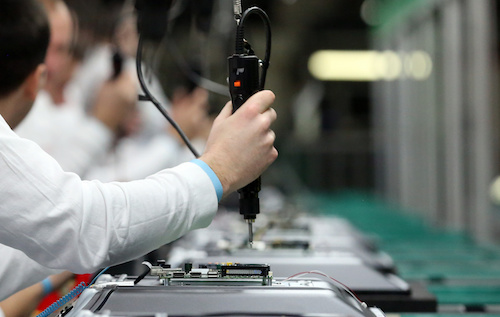AI Is Instrumental to Manufacturing Intelligence

Instrumental customers are able to identify the root cause of production line problems and quality snafus within a matter of minutes, without travel. Image Courtesy of Instrumental
Latest News
July 18, 2017
Products as high-tech as the Apple Watch or Samsung Galaxy are made in a relatively low-tech manner. In fact, most consumer electronics, no matter how cutting edge, are assembled by hand in overseas factories by low-cost labor—a scenario that even the largest and deep-pocketed U.S. manufacturers can find difficult to manage when they are a continent away.
 The Instrumental offering is an artificial intelligence/machine learning and camera-equipped inspection station. Image Courtesy of Instrumental.
The Instrumental offering is an artificial intelligence/machine learning and camera-equipped inspection station. Image Courtesy of Instrumental.Anna-Katrina Shedletsky and Samuel Weiss, both ex-Apple engineers, spent countless man hours on the ground in Chinese factories during the run up to the Apple Watch launch, and based on the difficulty of their experiences, they saw opportunity for a new solution. Their company, Instrumental, just launched its first product—an offering that leverages artificial intelligence/machine learning and camera-equipped inspection stations to help electronics companies remotely manage their product lines with an eye toward maximizing uptime, improving quality and accelerating time to market.
“We built a company to help manufacturers quickly find and fix issues on the manufacturing line so they don’t have to spend so much time in China,” Shedlestsky said.
The Instrumental station combines what the company describes as easy-to-deploy hardware and software set up that snaps images of each unit at key points in the assembly process as it moves through the production line. Those images are captured, allowing remote design and manufacturing engineers to inspect and take geometric measurements of all of the units as they pass through the production line, immediately or weeks after. The images are remotely searchable and comparable, and the machine learning aspect of the software, dubbed “Detect,” learns and reacts to assembly line data, which in turn helps identify units that appear defective, officials explained. Instrumental Detect automatically processes hundreds of units as they come off the line, effectively learning what is acceptable and what is considered a problem, as well as alerting engineers when it discovers anomalies.
 Instrumental customers are able to identify the root cause of production line problems and quality snafus within a matter of minutes, without travel. Image Courtesy of Instrumental.
Instrumental customers are able to identify the root cause of production line problems and quality snafus within a matter of minutes, without travel. Image Courtesy of Instrumental.Once an issue is found using the “Detect” feature, Instrumental lets engineers go a step further. The full set of software enables engineers to virtually disassemble units that might have a problem, taking measurements and other steps to zero in on exactly what’s wrong. The ability to perform intelligent trouble shooting from a distance enables teams to save significant time and money on travel while improving the communication between the company and the remote factories making the product. As a result, Instrumental says engineers are able to quickly resolve quality problems and take quick action on other issues.
So far, Instrumental says its customers have disassembled 16,000 unites and taken over 40,000 measurements, all remotely. The company is also touting widespread savings by its customers who are able to identify the root cause of production line problems and quality snafus within a matter of minutes, without travel, allowing them to restart lines faster and get higher quality products in consumers’ hands at a much faster pace. According to industry estimates, the traditional manual process for troubleshooting factory floor glitches can cause significant delays in time-to-delivery, costing companies as much as $6 million a day when assembly lines are down.
“Instrumental’s suite of products vastly improves efficiency via remote analysis functionality,” noted Lior Susan, managing partner at Eclipse Ventures, one of the venture capital firms backing the company, as well as the former manufacturing executive at Flextronics, in a prepared press release. “Furthermore, by incorporating information garnered by the latest data-generating, automation factory solutions, Instrumental can build the closed-loop feedback system required to deliver on the promise of the factory of the future.”
Instrumental’s CEO describes how the solution works in this video.
Subscribe to our FREE magazine, FREE email newsletters or both!
Latest News
About the Author
Beth Stackpole is a contributing editor to Digital Engineering. Send e-mail about this article to [email protected].
Follow DE





